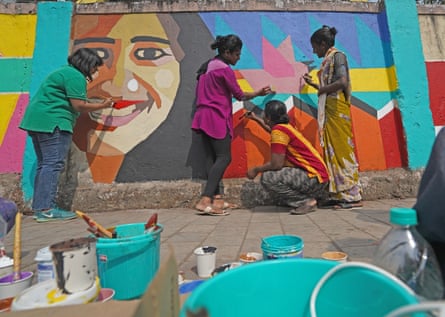Vivek Sharma has travelled 20km from his home to the congested eastern suburb of Mumbai for his HIV treatment. But the journey is no hardship for the 23-year-old student.
“My file was shifted to this clinic. I am so happy that this has finally happened.”
Sharma, who is bisexual, is waiting in the reception of a clinic believed to be India’s first specifically for the lesbian, gay, bisexual, transgender and queer (LGBTQ) community, having transferred his treatment from a government hospital closer to home.
“In any other [antiretroviral] waiting room of the city, I wouldn’t have been at such ease,” says Sharma, who was diagnosed as HIV positive in 2017. In between friendly chats with the clinic’s staff, he adds: “The crowd there would have immediately labelled me as homosexual and made sure I felt unwelcome.”
About 2.1 million people are HIV positive in India, one of the highest rates in the world. But access to treatment and services for gay people, as well as transgender people and female sex workers is poor. A 2016 Lancet paper on transgender health in India found that two-thirds of transgender people had no access to treatment for sexually transmitted infections. Only 59% had been referred for HIV testing and 67% had not been given proper counselling about antiretroviral therapy (ARV).
“We have known days when trans communities could not get past the doors of any public healthcare deliveries in India. Security does not let them in,” says Vivek Anand, CEO of the Humsafar Trust, which opened the clinic in February. The trust has advocated for the rights of the LGBT movement in India for 25 years.
All the clinic’s staff, from the receptionist, pharmacist to the counsellors, belong to the LGBT community. Humsafar has been running a clinic for HIV testing from its offices since 1999.
“Over the years, 30-40% of the individuals who tested HIV positive at our clinic disappeared at some point during their [ARV] treatment at government hospitals,” says Anand. “Half of them never even showed up. More than discrimination, self-stigmatisation keeps the community away from accessing treatment.”
Counselling is essential to ensure sexual minorities continue their treatment.
“The number of patients in public [ARV] centres is very high,” says Srikala Acharya, director of Mumbai District Aids Control Society. “They can’t provide patients with quality prevention counselling or lifestyle management skills.”
Humsafar fills this gap in its eight-room clinic. There are separate therapists for pre- and post-HIV testing, as well as general counsellors, and a social support group that meets monthly. A visiting psychiatrist is due to join the team.

“The clinic sees an annual footfall of over 8,000 people of which 70% belong to the lower socio-economic strata,” says Anand. “So treatment is free and voluntary donations are appreciated.”
Acharya believes the clinic’s location will help with retention rates. “[ARV] is a lifelong treatment,” she explains. “So it needs to done in a place that is decentralised and convenient. Humsafar is close to the workplace of high risk HIV/Aids population.”
However, V Sam Prasad, the country manager programme at Aids Health Foundation India, is sceptical of the Humsafar model of care. “Transgenders and MSM [men who have sex with men] in India are an extremely discreet population,” he says. “They aren’t going to look for such clinics. We need to go to them.”
The ministry of health and family welfare wants to “end Aids by 2030”. Though activists believe that the LGBT population haven’t become a priority with the government’s HIV policies. With more than 1,600 public ARV centres across the country none solely cater to LGBT people.
Anand feels the solutions lies in community action. He believes Humsafar’s clinic is a step forward for the LGBT population to become “self-sufficient” within the health system.
“Somewhere deep down, discrimination and stigma just do not go away,” he says. “So communities need to drive their own agenda. We cannot wait forever.”
